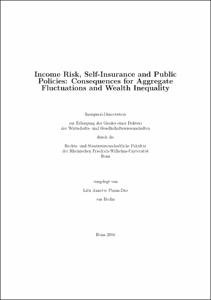Income Risk, Self-Insurance and Public Policies: Consequences for Aggregate Fluctuations and Wealth Inequality

Income Risk, Self-Insurance and Public Policies: Consequences for Aggregate Fluctuations and Wealth Inequality

| dc.contributor.advisor | Bayer, Christian | |
| dc.contributor.author | Pham-Dào, Liên Annette | |
| dc.date.accessioned | 2020-04-22T17:59:37Z | |
| dc.date.available | 2020-04-22T17:59:37Z | |
| dc.date.issued | 20.10.2016 | |
| dc.identifier.uri | https://hdl.handle.net/20.500.11811/6828 | |
| dc.description.abstract | This thesis investigates quantitatively the distributional and aggregate outcomes that result from the interaction of income risk, self-insurance motives and public policies. The first chapter assesses the business cycle and welfare consequences of fluctuations in idiosyncratic income risk and the role played by monetary policy. It is shown in a New Keynesian model with sticky prices, incomplete markets, and portfolio choice between liquid and illiquid assets that in times of heighted income uncertainty households increase their demand for precautionary savings and rebalance their portfolio toward the liquid ``paper'' asset, as it provides better consumption-smoothing services. This reduces their aggregate demand for consumption goods and illiquid physical capital, leading to considerable output losses. By accommodating a heightened demand for liquidity, the central bank can stabilize output and reduce the overall welfare costs from uncertainty shocks. The second chapter assesses the aggregate effects of fiscal transfers to households financed by a transitory increase in government debt. Debt-financed transfers increase individual liquidity and enhance market liquidity through a higher net supply of government bonds. As the government reverts its debt, households want to hold on to their improved consumption-smoothing capacity and shift their assets into illiquid capital. This crowding in of investment makes the aggregate effects of fiscal transfers expansionary independent of the mode of future financing. The third chapter quantifies the importance of euro area differences in labor market dynamics and public insurance mechanisms for cross-country differences in private net wealth inequality. Revisiting the argument by Hubbard et al. (1995) that public insurance crowds out private savings especially of the poor, I construct a life-cycle model with heterogeneous households and incomplete markets that features exogenous labor market risks, unemployment benefits, mean-tested minimum income support and public and occupational pensions. Calibrating the model to the actual euro area differences in those institutions, I find that they are key determinants of the wealth distribution and can account for 70.1% of the cross-country differences in the net wealth Gini coefficients for the bottom 95% of the wealth distribution. | en |
| dc.language.iso | eng | |
| dc.rights | In Copyright | |
| dc.rights.uri | http://rightsstatements.org/vocab/InC/1.0/ | |
| dc.subject.ddc | 330 Wirtschaft | |
| dc.title | Income Risk, Self-Insurance and Public Policies: Consequences for Aggregate Fluctuations and Wealth Inequality | |
| dc.type | Dissertation oder Habilitation | |
| dc.publisher.name | Universitäts- und Landesbibliothek Bonn | |
| dc.publisher.location | Bonn | |
| dc.rights.accessRights | openAccess | |
| dc.identifier.urn | https://nbn-resolving.org/urn:nbn:de:hbz:5-45216 | |
| ulbbn.pubtype | Erstveröffentlichung | |
| ulbbnediss.affiliation.name | Rheinische Friedrich-Wilhelms-Universität Bonn | |
| ulbbnediss.affiliation.location | Bonn | |
| ulbbnediss.thesis.level | Dissertation | |
| ulbbnediss.dissID | 4521 | |
| ulbbnediss.date.accepted | 29.07.2016 | |
| ulbbnediss.institute | Rechts- und Staatswissenschaftliche Fakultät / Fachbereich Wirtschaftswissenschaften : Institut für Makroökonomik und Ökonometrie | |
| ulbbnediss.fakultaet | Rechts- und Staatswissenschaftliche Fakultät | |
| dc.contributor.coReferee | Hintermaier, Thomas |
Files in this item
This item appears in the following Collection(s)
-
E-Dissertationen (288)




